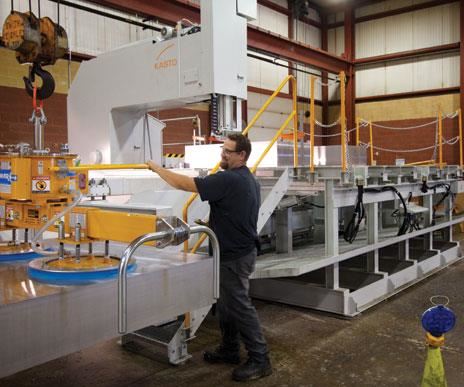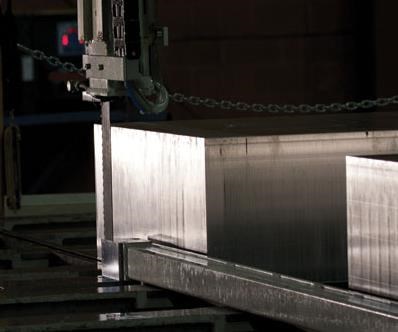Benefiting from the Properties of High-Strength Aluminum
When designed and engineered properly, high-strength aluminum has become a mainstream tooling material.
The December issue’s Dispelling Aluminum Tooling Myths article by Robert Lammon underscores that today’s high-strength aluminum alloys can be a successful alternative to steel tooling. The article went through eight industry misconceptions, mainly related to durability, when considering aluminum for production injection mold tooling. The article touched upon solutions that mold builders and processors alike are using to take advantage of the benefits of high-strength aluminum. Used today for the cycle time advantage, high-strength aluminum alloys are making an impact in automotive, commercial and industrial injection molds as a competitive alternative to steel.
Breaking down these myths even further, one must consider the range of aluminum products that are commercially available for the moldmaking industry. During the mid-1980s aluminum manufacturers were taking advantage of high-strength aerospace aluminum plate and pursuing applications in the area of prototype injection mold tooling. By taking advantage of aluminum’s superior machining performance, prototype mold builders could design, machine and build molds in mere days and have tangible parts to show customers.
At the same time, aluminum alloys in the 2000 and 5000 series also were utilized for prototype tooling driven mainly by cost. As cast products, these aluminum materials had less processing, and therefore cost about half that of 7000 series material at the time. The mechanical properties of these materials were sufficient for the prototype parts they were producing, albeit significantly less hard than 7000 series aluminum.
The cycle time benefit when using aluminum was largely overlooked since prototype tools provided product designers and engineers the plastic component they desired. Changes to the plastic component for fit and form were re-engineered and applied to the steel tool design for the production tool. However, as mold shops began to use 7000 series aluminum, it was quickly realized that these alloys possessed higher hardness, improved machining characteristics and a cycle time advantage. With efforts to better understand how to polish, texture and repair these materials, molders began benefiting from the properties of high-strength aluminum.
Today’s High-Strength Aluminum
One of the important developments of 7000 series aluminum has been consistent through thickness strength across sections of material in excess of 8 inches. 7000 series alloys are characterized by the primary alloying element, zinc. Other elements including magnesium and copper in combination with zinc produce the highest strength family of aluminum alloys. Advancements in alloy development has led to 7000 series aluminum alloys with improved properties through the entire thickness of a finished mold block.
Rolled plates of these alloys provide excellent strength in thickness sections up to 8 inches. Forged mold block takes advantage of recently developed alloys that maintain through thickness strength. To develop the strength properties of 7000 series aluminum, it must be hot worked from a starting ingot: slabs for rolled plate and ingots for forged blocks. The building up of properties in high-strength aluminum involves both mechanical processes (rolling, forging or extruding) and thermal processes (heat treat, quenching and aging).
To acquire the higher yield strength of today’s high-strength aluminum, the manufacturing flow path involves these basics metalworking steps:
• Ingot casting: 7000 series aluminum requires precise measurement of the alloying constituents (zinc, copper and magnesium), by weight percentage as developed by the aluminum manufacturer.
• Hot working (mechanical process): Depending upon the output gauge, aluminum is either hot rolled to plate sizes, typically 8 inches and below or hot forged for thicknesses greater than 8 inches.
• Heat treatment and quench (thermal process): To assure dispersion of alloying elements and a rapid cooling of the heat treated aluminum to build the strength characteristics in the 7000 series alloy matrix
• Cold work (mechanical process): A process to reduce residual stress by stretching the plate or by cold compressing in a large forging press.
• Temper (thermal process): A solution heat treatment and the artificial aging process.
Aluminum Challenges and Strategies
Bob Lammon, Phoenix Prototype, said it well, “Like most successful innovations that are born from the need to survive, aluminum tooling is not just the bridge to a faster product launch or the cost savings necessary for the planned budget; it is a successful alternative to steel tooling with huge benefits that will continue to advance and influence the future of the plastics industry.”
The challenge remains how to tap into the process efficiency of aluminum. With impressive improvements in cycle time—as much as 60 percent in some cases—knowledge and training in the plastics processing industry can’t happen soon enough.
As evidence with the much reported successes at Honda reaches molders, the barriers to adoption of high-strength aluminum are beginning to weaken. In the case of the one production part that has exceeded 600,000 parts, the mold not only performed better than expected, it has fortified the notion that aluminum tooling can, in fact meet manufacturing and quality requirements.
A key element to successful implementation of an aluminum tooling strategy needs to focus on the benefits that aluminum tooling can deliver for components that make the most sense and will have the highest success rate. Components that make the most sense for first-time aluminum usage include unfilled, general-purpose resins, such as polypropylene or polyethylene, though not limited to these; flat geometry over deeply drawn parts; and, generous draft angles for ejection.
Summary
The adoption of productionized aluminum tooling as an alternative to steel does require open communication between the aluminum manufacturer and supplier, the mold shop and molder. Not all aluminum alloys are created equal; just as not all steels are created equal. Designed and engineered properly, high-strength aluminum is beginning to take a foothold as a mainstream tooling material for years to come.
Related Content
The Benefits of Hand Scraping
Accuracy and flatness are two benefits of hand scraping that help improve machine loop stiffness, workpiece surface finish and component geometry.
Read MoreHow to Determine the Proper Vent Depth
Vent depth is critical to optimizing mold performance, so here is one approach to finding that elusive right number.
Read MoreMaking Quick and Easy Kaizen Work for Your Shop
Within each person is unlimited creative potential to improve shop operations.
Read MoreMaintaining a Wire EDM Machine
To achieve the ultimate capability and level of productivity from your wire EDM on a consistent, repeatable and reliable basis, regular maintenance is a required task.
Read MoreRead Next
Dispelling Aluminum Tooling Myths
Myths have always been around: the world is flat and the sun revolves around the earth— to name a few.
Read MoreHow to Use Continuing Education to Remain Competitive in Moldmaking
Continued training helps moldmakers make tooling decisions and properly use the latest cutting tool to efficiently machine high-quality molds.
Read MoreReasons to Use Fiber Lasers for Mold Cleaning
Fiber lasers offer a simplicity, speed, control and portability, minimizing mold cleaning risks.
Read More

















.jpg;maxWidth=300;quality=90)







